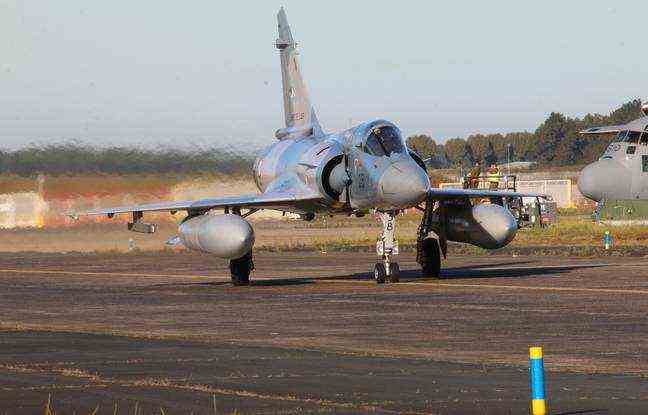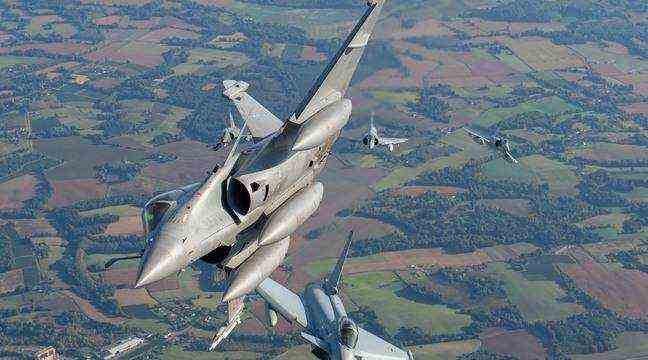The air base 118 of Mont-de-Marsan (Landes) is on alert this Thursday. Twenty-four hours after having received a response from the enemy, it continued its offensive which had started a few days earlier. In a deafening noise, Eurofighter, Mirage 2000, Rafale, take off from the Landes runways. Their mission for the day will be to destroy an opposing ground-to-air site near Aurillac (Cantal), to find a military convoy and at the same time to organize strikes on storage sites.
The day before, “the enemy had launched on our base of Mont-de-Marsan a massive raid based on Spanish F-18s left from the Iberian border, and helicopters which arrived from the base of Cazaux (Gironde), tells Colonel Gilles. For over two hours, we had to counter this threat with our fighter jets that we had placed on alert, and using our mamba ground-to-air defense system that protects the base. “
Rest assured, there was no damage, except for the ears in the vicinity of the base, since this is only an exercise. But a very large exercise. On a territory of 240 km by 200 km, the 2021 edition of Volfa must allow the forces of the Air Force and Space to train “at high intensity. “
A scenario that is intended to be as realistic as possible
If the missile fire remains only points on a screen, the Volfa exercise really mobilizes about fifty aircraft, and some 850 airmen. The Air Force has deployed on the bases of Mont-de-Marsan and Cazaux fighter planes, transport planes, helicopters, a drone and an Awacs… “We also have the parachute commandos, and the air traffic controllers who are the eyes and ears of fighter pilots, continues Colonel Gilles. The idea is really to train like in war ”, insists the director of this exercise Volfa which started on September 25 and which is due to end on October 14.

For this, a scenario, which is intended to be as realistic as possible, was established by the armed forces. An invader – the Reds – annexed a territory within Auvergne. The mission of the “good guys” – the blues – will be to get it back by the end of the exercise.
Entry Force logic
Back from his mission on Thursday noon, Commander Florent, pilot of Mirage 2000 D at the Nancy air base, says that “not everything always goes according to plan. “” Today, for example, a drone was programmed, it was he who had to search for the military convoy on the ground. But it was destroyed by a surface-to-air system, so we had to replace it with our Mirage 2000 D, which is more complicated, since our mission is the attack on the ground. You have to adapt, and that’s what the exercise is for. We will learn from all of this during the debriefing. “
#Army #planes Mirage, Rafale, Eurofighter … The BA 118 of Mont-de-Marsan welcomes around fifty aircraft for a defense exercise on a European scale pic.twitter.com/muXFnneNHU
– 20minutesbordeaux (@ 20minutesbord) October 7, 2021
The blues offensive started on Monday. In the logic of Entry Force, the ability to enter first into a territory where one does not have air superiority, “the objective is to penetrate the enemy zone to destroy its ground-air system in order to break its bubble of protection, and to resume this air superiority, ”explains Colonel Gilles.
The next day, Tuesday, “we began to strike deep towards the command centers to reduce their coordination and defense capabilities, then we parachuted troops to start occupying the field, with transport planes and helicopters. At the same time, a parachute commando was deployed on the side of Aurillac Thursday evening, this time to carry out an evacuation of European nationals.
“A limited stock of missiles is not an ‘open bar'”
The mobilization of troops does not only happen in the air. In the room of the collaborative combat expert center (CECC), Commander Yann pilots Jeannette, “a support tool for the armed forces, connected to radars and aircraft radios” thanks to which he can “see everything” in aircraft, from the level of fuel remaining to the number of missiles fired. “I can also place fake planes in the air to create a lot of threat in the face of the enemy, simulate supersonic flights over French territory” (which is prohibited in the exercise, supersonic flights “in real life “being made over the Atlantic).
In another room next door, several experts, a red side, a blue side, accompany the crews in the air in the animation of their missions, which they can make evolve according to the changes of context. When a crew is hit and considered dead, a small coffin materializes on screen. “He must then return to base, even if this occurs after three minutes of mission,” said Commander Yann. I can tell you that the pilots are very careful that this does not happen. And whether it is for the attack or the response, we only give them a limited stock of missiles, it is not “open bar”, precisely to get as close as possible to reality … “
“The established scenario evolves according to what we succeed or not”
“We present the missions to the pilots the day before or the day before, it is then up to them to implement the tactics, with a rhythm of two missions per day, and three missions on Tuesdays and Thursdays”, indicates the colonel. Gilles. “Each mission lasts more than a day altogether,” adds Commander Florent, “but it is above all the preparations that are long, the duration of the flights being around 3 hours. “Knowing that you must return without loss, otherwise it is” mission failed “.
The Volfa exercise has existed since 2016. But this is the first year that it has been deployed in this form. “What is new is to have consistency and continuity throughout the exercise,” insists Colonel Gilles. We wanted to place our crews in very realistic situations, and each day the established scenario evolves according to what we succeed or not. “
“The highest level of training”
It is also an exercise at European level, insists its manager, even if all the countries invited have not responded. The Luftwaffe, the German air force, moved with four Eurofighter fighter jets, Canada with three helicopters and a C-130 (Hercules), while the Swiss with their F-18s and the Spaniards with also F-18s and a A400M, play from their respective homes.
The objective is “to train for the conflicts of tomorrow, affirms Colonel Gilles, because in recent conflicts such as Afghanistan or Mali, we have only worked with a small part of our equipment, compared to what is required. ‘we are able to deploy’. “This gives us the highest level of training for a conflict that would take place against forces equivalent to ours,” adds Commander Florent. Complex procedures “which we do not train often. This is high intensity ”.

